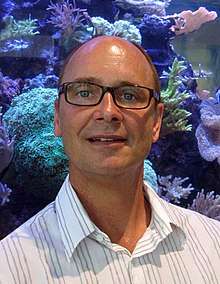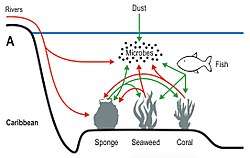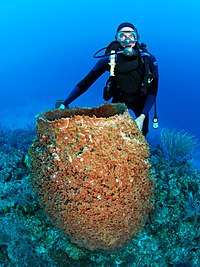Joseph Richard Pawlik
Joseph Richard Pawlik is a marine biologist. He is the Frank Hawkins Kenan Distinguished Professor of Marine Biology[1] in the Department of Biology and Marine Biology at the University of North Carolina Wilmington. He is best known for studies of sponges on Caribbean coral reefs that reveal ecological principles such as resource trade-offs, trophic cascades and indirect effects.
Joseph Richard Pawlik | |
|---|---|
 | |
| Born | Minneapolis, Minnesota, United States |
| Nationality | American |
| Alma mater | University of Minnesota Scripps Institution of Oceanography University of California, San Diego |
| Known for | Ecology of sponges on Caribbean reefs |
| Scientific career | |
| Fields | Zoology Marine Biology Chemical Ecology |
| Institutions | University of North Carolina Wilmington |
| Doctoral advisor | D. John Faulkner Nicholas D. Holland |
Early life and education
Pawlik was born in Minneapolis, Minnesota to Richard Joseph Pawlik and Shirley Joyce (Reed) Pawlik as the third of 4 children. He credits his early childhood interest in marine biology to watching public television broadcasts of The Undersea World of Jacques Cousteau.[2] He was raised in the City of St. Anthony Village, a suburb northeast of Minneapolis and graduated in 1978 from St. Anthony Village High School.[3] In 1982, he graduated with a BS degree in Biological Sciences from the University of Minnesota, Twin Cities[4] after taking summer courses his sophomore and junior years at the Bermuda Biological Station for Research, now BIOS.
Work

Pawlik did his graduate research on the chemical cues that cause the planktonic larvae of marine invertebrates to metamorphose into sessile adults, focusing on sandcastle worms, a group of annelid worms that build tubes of sand that can form reefs.[5] In collaboration with the natural products chemists in the laboratories of his mentors, D. John Faulkner and William Fenical, he began working on the chemical defenses of marine invertebrates, including limpets,[6] gorgonian corals,[7] and sea slugs.[8][9] At UNCW, Pawlik began working on the chemical defenses of sponges on Caribbean reefs,[10] a project that was funded by the National Science Foundation for over 23 years. With his students and collaborators, Pawlik characterized the chemical defenses of over 100 species of sponges across the Caribbean, and discovered a resource trade-off between the production of defensive secondary metabolites versus growth or reproduction among sponge species.[11] Originally demonstrated with manipulative experiments,[12] the resource-trade off was subsequently validated in surveys across the Caribbean by targeting reefs that were intensively overfished versus those that had been protected from fishing.[13] On overfished Caribbean reefs, the absence of sponge predators resulted in the overgrowth of reef-building corals by fast growing, chemically undefended sponge species,[14] providing unambiguous evidence to support fishing restrictions to protect coral reefs.
Most recently, Pawlik and colleagues have integrated the chemical defense-based ecosystem model with evidence of increasing sponge abundance[15] and new data on carbon and nutrient cycling by sponges[16][17] to propose the “vicious circle hypothesis” to explain the lack of resilience of Caribbean coral reefs relative to reefs in the Indo-Pacific.[18]
Honors
- Frank Hawkins Kenan Distinguished Professor of Marine Biology, UNCW – 2017
- Honorary naming of Elysia pawliki by Dr. Patrick Krug[19] - 2017
- Chief Scientist on 13 UNOLS research vessel cruises – 1998-2013
- Associate Program Director, Biological Oceanography, NSF – 2003-2005
- National Science Foundation Presidential Young Investigator Award[20] – 1991
Scientific debates

Pawlik is a proponent of critical rationalism for the advancement of science; he discusses the concept in the courses he teaches[21] and has openly challenged the conclusions of other studies throughout his career. As a graduate student he contested the claim that neurotransmitters were related to the natural inducers of marine invertebrate larval settlement, arguing that the results of still-water, laboratory experiments with bioactive compounds were artifacts and not ecologically relevant.[22][23] Along with collaborators, he has challenged the idea that sponges of the genus Aplysina protect themselves with “activated” chemical defenses.[24][25] Among marine invertebrates, such as nudibranch molluscs, he has found little evidence for optimized chemical defense strategies, warning coloration, or mimicry.[26]
More recently, Pawlik and colleagues have challenged the claim that sponge communities on Caribbean reefs are primarily controlled by bottom-up factors (food availability), instead asserting that community structure is primarily a product of top-down control (due to predation).[27][28]
Videography
Pawlik has been an amateur underwater photographer since the 1980s, but recently turned to video to capture the current state of coral reef environments and to provide outreach related to his scientific publications. His videos are posted on YouTube at the channel “Pawlik Lab." Two short videos, “Sponges of the Caribbean"[29] and “The maid did it!"[30] were finalists in the Ocean 180 video challenge,[31] a science video outreach competition sponsored by the National Science Foundation, in 2015 and 2016, respectively.
See also
References
- Guthrie, Gena. "Frank Hawkins Kenan Distinguished Professorship of Marine Biology".
- Pawlik, J.R. (2017). "About the Pawlik Lab YouTube Channel".
- Bucko, T., Beaubien, S., Berg, J., Yurek, L.A., Johnsen, D., Jasinski, S., Plotnik, R. (1978). Villager 1978: Memories and Photographs, the St. Anthony Village High School Yearbook. Volume 17.
- Pawlik, J.R. (2017). "Curriculum Vitae".
- Pawlik, J.R. (1986). "Chemical induction of larval settlement and metamorphosis in the reef-building tube worm Phragmatopoma californica (Polychaeta: Sabellariidae). Marine Biology, 91: 59-68" (PDF).
- Pawlik, J.R., Albizati, K.F., Faulkner D.J. (1986). "Evidence of a defensive role for limatulone, a novel triterpene from the intertidal limpet Collisella limatula. Marine Ecology Progress Series, 30: 251-260" (PDF).
- Pawlik, J.R., Burch, M.T., Fenical W. (1987). "Patterns of chemical defense among Caribbean gorgonian corals: a preliminary survey. Journal of Experimental Marine Biology and Ecology, 108: 55-66" (PDF).
- Pawlik, J.R., Kernan, M.R., Molinski, T.F., Harper, M.K., Faulkner D.J. (1988). "Defensive chemicals of the Spanish Dancer nudibranch, Hexabranchus sanguineus, and its egg ribbons: Macrolides derived from a sponge diet. Journal of Experimental Marine Biology and Ecology, 119: 99-109" (PDF).
- Pawlik, J.R., Kernan, M.R., Molinski, T.F., Harper, M.K., Faulkner, D.J. (1990). "Secondary metabolites of the chemically rich ascoglossan Cyerce nigricans. Experientia, 46: 327-329" (PDF).
- Pawlik, J.R., Chanas, B., Toonen, R.J., Fenical, W (1995). "Defenses of Caribbean sponges against predatory reef fish: I. Chemical deterrency. Marine Ecology Progress Series, 127: 183-19" (PDF).
- Pawlik, J.R. (2011). "The chemical ecology of sponges on Caribbean reefs: Natural products shape natural systems. BioScience, 61: 888-898" (PDF).
- Leong, W., and Pawlik, J.R. (2010). "Evidence of a resource trade-off between growth and chemical defenses among Caribbean coral reef sponges. Marine Ecology Progress Series, 406: 71-78" (PDF).
- Loh, T.-L., and Pawlik, J.R. (2014). "Chemical defenses and resource trade-offs structure sponge communities on Caribbean coral reefs. Proceedings of the National Academy of Sciences, 111: 4151-4156" (PDF).
- Loh, T.-L., McMurray, S.E., Henkel, T.P., Vicente, J. and Pawlik, J.R. (2015). "Indirect effects of overfishing on Caribbean reefs: sponges overgrow reef-building corals. PeerJ, 3: e901". PeerJ. 3: e901. doi:10.7717/peerj.901. PMC 4419544. PMID 25945305.
- McMurray, Steven E.; Finelli, Christopher M.; Pawlik, Joseph R. (2015). "Population dynamics of giant barrel sponges on Florida coral reefs" (PDF). Journal of Experimental Marine Biology and Ecology. 473: 73–80. doi:10.1016/j.jembe.2015.08.007.
- de Goeij, JM; van Oevelen, D; Vermeij, MJ; Osinga, R; Middelburg, JJ; de Goeij, AF; Admiraal, W (2013). "Surviving in a marine desert: The sponge loop retains resources within coral reefs". Science. 342 (6154): 108–110. doi:10.1126/science.1241981. PMID 24092742.
- McMurray, Steven E.; Johnson, Zackary I.; Hunt, Dana E.; Pawlik, Joseph R.; Finelli, Christopher M. (2016). "Selective feeding by the giant barrel sponge enhances foraging efficiency" (PDF). Limnology and Oceanography. 61 (4): 1271–1286. doi:10.1002/lno.10287.
- Pawlik, Joseph R.; Burkepile, Deron E.; Vega Thurber, Rebecca (2016). "A vicious circle? Altered carbon and nutrient cycling may explain the low resilience of Caribbean coral reefs" (PDF). BioScience. 66 (6): 470–476. doi:10.1093/biosci/biw047.
- Krug, PJ; Vendetti, JE; Valdés, Á (2017). "Molecular and morphological systematics of Elysia Risso, 1818 (Heterobranchia: Sacoglossa) from the Caribbean region". Zootaxa. 4148: 1. doi:10.11646/zootaxa.4148.1.1. PMID 27515641.
- "National Science Foundation Presidential Young Investigator Award". 1991.
- Pawlik, J.R. (2017). "BIO 501 Syllabus – Introduction to Science as a Profession. University of North Carolina Wilmington" (PDF).
- Pawlik, J.R. (1990). "Natural and artificial induction of metamorphosis of Phragmatopoma lapidosa californica (Polychaeta: Sabellariidae), with a critical look at the effects of bioactive compounds on marine invertebrate larvae. Bulletin of Marine Science, 46: 512-536" (PDF).
- Pawlik, J.R. (1992). "Chemical Ecology of the Settlement of Benthic Marine Invertebrates. Oceanography and Marine Biology: An Annual Review, 30: 273-335" (PDF).
- Puyana, M., Fenical, W., and Pawlik, J.R. (2003). "Are there activated chemical defenses in sponges of the genus Aplysina from the Caribbean? Marine Ecology Progress Series, 246: 127-135" (PDF).
- Puyana, M., Pawlik, J.R., Blum, J., Fenical, W. (2015). "Metabolite variability in Caribbean sponges of the genus Aplysina. Brazilian Journal of Pharmacognosy, 25: 592-599" (PDF). Cite journal requires
|journal=(help) - Pawlik, J.R. (2012). "Antipredatory defensive roles of natural products from marine invertebrates. Chapter 12, pages 677-710 in Handbook of Marine Natural Products. Edited by: Fattorusso, E., Gerwick, W.H., Taglialatela-Scafati, O. Springer Science, NY" (PDF).
- Pawlik, J.R., McMurray, S.E., Erwin, P. and Zea, S. (2015). "A review of evidence for food-limitation of sponges on Caribbean reefs. Marine Ecology Progress Series, 519: 265-283" (PDF). Cite journal requires
|journal=(help) - Pawlik, J.R., McMurray, S.E., Erwin, P. and Zea, S. (2015). "No evidence for food limitation of Caribbean reef sponges: Reply to Slattery & Lesser (2015). Marine Ecology Progress Series, 527: 281-284" (PDF). Cite journal requires
|journal=(help) - "Sponges of the Caribbean".
- "The maid did it!".
- "Ocean 180 Video Challenge".